Composting of Banana Leaves and Coconut Leaves Using EM4 Bioactivator
on
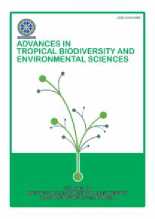
Advances in Tropical Biodiversity and
Environmental Sciences
6(1): 8-12, February 2022
e-ISSN:2622-0628
DOI:10.24843/ATBES.2022.v06.i01.p02
Available online at: https://ojs.unud.ac.id/index.php/ATBES/article/view/76900
Composting of Banana Leaves and Coconut Leaves Using EM4 Bioactivator
Nova Ulhasanah1, Ariyanti Sarwono1, Michael Yosafaat1, Dennis Filippi1, I Wayan Koko Suryawan1*, and I Made Wahyu Wijaya2
1Faculty of Infrastructure Planning, Department of Environmental Engineering, Pertamina University, Complex Universitas Pertamina,
Jalan Sinabung II, Terusan Simprug, Jakarta 12220, Indonesia 2Postgraduate Program of Regional Development Planning and Environmental Management, Mahasaraswati University, Denpasar, 80233, Indonesia
*Corresponding author: i.suryawan@universitaspertamina.ac.id
Abstract. The generation of organic waste is one of the biggest problems in developing countries like Indonesia. Examples of organic waste that can be obtained, such as leaves, include banana leaves and coconut leaves. One way to process waste that can generally be done is by composting. In the composting process, a bioactivator such as EM4 is needed to accelerate the reaction process in the waste. This study aimed to determine the effectiveness of EM4 bioactivator in the degradation process of banana leaf and coconut leaf waste. Measurement of processing quality is measured in-situ with parameters of temperature, pH, and humidity. The waste temperature increased above 32oC for the addition of EM4 bioactivator, while without the addition of bioactivator it only increased to 31oC. pH tended to be in normal conditions and was in an acidic state on day 12. Humidity decreased from the beginning of the waste process to the end of the process. The final result of composting quality has met the criteria of SNI 19-7030-2004. There was also a decrease in the C/N content during the process, adjusting to soil conditions. The decrease in the value of C/N on the addition of bioactivator also influences the composting process.
Keywords: compost, leaves, banana, coconut, C/N
-
I. INTRODUCTION
The volume of waste in Indonesia is increasing along with the increase in population. Municipal solid waste is the residue of daily human activities and natural processes in the solid form [1]. The increasing amount of waste is also experienced in several regions in Indonesia during the Covid-19 pandemic [2]–[4]. The accumulation of this waste can lead to new problems. The current existence of waste can produce something that can provide benefits if it can be handled and processed correctly. One example of an area experiencing waste management problems is the Province of Bali. As part of Balinese culture, offerings of flowers, leaves, fruits, and bamboo are served in almost every traditional ceremony [5]. Worship is a Balinese way of life. The waste composition from this activity includes flowers, leaves, coconut, fruit, bamboo, food waste, cloth, and plastic, including banana leaf and coconut leaf waste.
The people of the island of Bali show that there are residents who are starting to realize the importance of processing waste in the surrounding environment to produce something more beneficial for the surrounding environment. What these residents do is utilize dry leaf waste to be processed into compost.
Saputra et al. stated compost made from agricultural biomass results from dismantling complex compounds into simple ones with the help of microbes in the soil, namely Trichoderma sp [6]. Meanwhile, the microorganism in the EM4 formulation is a starter material where the microorganism takes advantage of the speed up the reaction rate [7], which is beneficial for soil fertility. Making compost by utilizing the EM4 formulation following the correct dosage based on the instructions and a decomposer in making compost. Therefore, the population and viability of microbes in the soil will develop healthy again to improve the texture and structure
of the soil for the better, which can affect the increase in the productivity of cultivated plants to be high [8].
This study aimed to determine the quality of composting products from banana leaf and coconut leaf waste with the addition of an EM4 bioactivator. This study also looks at the comparison of composting results with SNI 19-7030-2004.
-
II. RESEARCH METHOD
-
A. Composting Method
Composting is carried out with a compost reactor with a size of 2 L. The reactor is divided into two parts, namely the section for processed waste. At the same time, the bottom consists of leachate collectors. In this composting process, the weight of the waste used is 500 grams, and the waste is counted first so that the diameter of the waste is less than 1 cm.
Next, mix all the ingredients above into the composting box and stir until evenly distributed with the addition of Nitrobacter activator from EM4. As a control, there is also a composting process without the addition of EM4. The amount of addition of EM4 is done using the ratio of the composter's total size, which is 1:25 (v/v). This was done with the approach of the lasters study literature [9]. The variations used in this study can be seen in Table 1. Composting was carried out with a detention time of 4 weeks. Then the composting results are compared with the compost standard according to SNI 19-7030-2004.
TABLE I
VARIATIONS IN COMPOSTING STUDIES
|
Variabel |
Kode | |
|
With EM4 |
Banana leave Coconut leave |
BL4 CL4 |
|
Without EM4 |
Banana leave |
BL0 |
|
Coconut leave |
CL0 | |
-
B. Compost Quality Measurement
Measurement of compost quality based on the content of C, N, P, and K was carried out at the Animal Research Institute (Balitnak). The water content was tested by the gravimetric method at a temperature of 105oC. Meanwhile, pH was measured ex-situ at the study site with a pH meter. Meanwhile, as an indicator of the processing process, temperature and moisture content measurements are also carried out in the composting process
-
III. RESULT AND DISCUSSION
The initial characteristics of banana leaf and coconut leaf waste can be seen in Table 2. Parameters affecting the
composting process are the C/N ratio, water content, oxygen concentration, temperature, pH, and others from the raw materials to be composted. The ratio between Carbon and Nitrogen (C/N) ideal ratio is between 20 to 40 to 1 or 30 to 1, which is the best ratio. Municipal waste has a C/N ratio of 30 to 40 to 1, so it is optimal enough to support the composting process to run well [10]. However, several studies also show that a C/N ratio above 10 is sufficient for the degradation process of organic compounds [7], [11]–[13].
TABLE II
RESULTS OF MEASUREMENT OF THE INITIAL
CHARACTERISTICS OF WASTE
|
Parameter |
Unit |
Banana leaves |
Coconut leaves |
|
Water Content |
% |
46% |
37% |
|
pH |
- |
7.5 |
7.3 |
|
C |
% |
28.4 |
30.4 |
|
N |
% |
2.2 |
1.85 |
|
P |
% |
0.41 |
0.44 |
|
K |
% |
0.31 |
0.53 |
|
C/N |
- |
12.91 |
16.43 |
The temperature in each variation began to increase and was in the range of 26 - 34oC (Figure 1). Temperatures above 40oC cause mesophilic bacteria to die. This type of bacteria is not resistant to high temperatures; bacteria living in this condition are thermophilic. Temperatures under thermophilic conditions can eliminate pathogens better, but thermophilic temperatures have a high degree of stability [14]. The increased temperature is due to the increased activity of microorganisms in decomposing organic matter, resulting in much faster heat production. After reaching the maximum temperature, the temperature will decrease until the decomposition process has been completed [15].
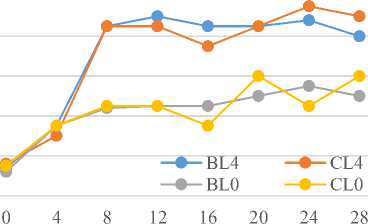
Time (d)
Figure 1. Changes in temperature in the composting
process for 28 days
The pH value of the composting variation is still in the stable pH range of 6.0 - 7.5 (Figure 2), this condition is
included in the optimum pH range in the aerobic organic waste decomposition process. The pH range that allows the activity of microorganisms to run optimally is in the range of 6.0 - 7.5 [16]–[18].
505
500
495
490
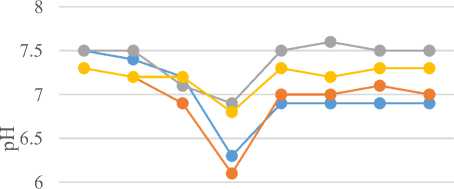
5.5
BL4 CL4 BL0 CL0
E? 485 480 475 470 465 460 455 450
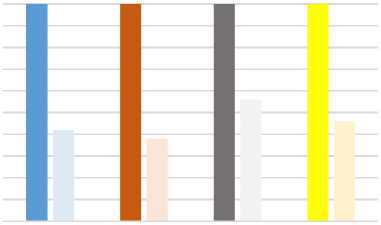
BL4
CL4
BL0
CL0
■ td0 td28
5
0 4 8 12 16 20 24 28
Time (d)
-
Figure 2. Changes in pH value during the composting process
Moisture on banana leaves and coconut leaves during the composting process was in the range of 39.0 – 46.0% and 30-39%, respectively (Figure 3). This situation is still in the optimum humidity range in the organic waste decomposition process, and the optimum moisture ranges from 40.0 – 60.0% [19]. Moisture content below 40.0% will cause microbial activity to decrease and will be even lower at 15.0% [20].
50
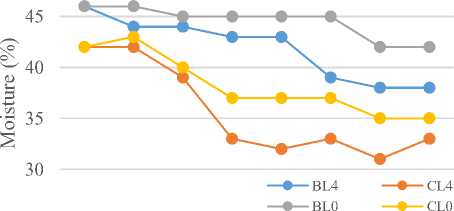
25
0 4 8 12 16 20 24 28
Time (d)
-
Figure 3. Changes in Moisture Content in the Composting Process
Changes in mass during the composting process occur due to the degradation process by microorganisms. The use of organic and the evaporation process in the composting process tends to gradually reduce the waste's mass. During the processing, each reactor tends to show a decrease in mass. However, the addition of bioactivators tends to increase the amount of material that can be degraded (Figure 4).
-
Figure 4. Mass Change in Composting Process for day 0 and day 28
The results of the analysis of the compost quality are compared with SNI 19-7030-2004 to determine whether the compost has met the criteria of the Indonesian National Standard (SNI) and is suitable for use on plants. The analysis of manure and its comparison are SNI 19-70302004 concerning specifications for compost from domestic organic waste. When compared with SNI 19-7030-2004, the pH values in all processing products tend to be in the range required by the standard (Table 3). Its pH will be neutral. If the compost results in acidic conditions, the compost tends to be immature [21].
The content of C and N in the waste tends to decrease from the initial concentration. In the composting process, carbon acts as an energy source for microorganisms, and nitrogen plays a role in the formation of microorganisms. During the composting process, CO2 will experience evaporation so that the carbon (C) content will decrease and the nitrogen (N) level will increase. This causes the C/N ratio of the compost to decrease. The principle of composting is to reduce the value of the C/N ratio of organic matter to be equal to the value of the C/N ratio of the soil (<20) [22]. With the same C/N ratio as the soil, it will facilitate the absorption of compost content into the soil. The level of the C/N ratio at the beginning of the composting period dramatically affects the rate of the composting process. A low initial C/N ratio will make the decay process faster, during a high initial C/N ratio because it has a high carbon content will make the decay process longer.
In this research, the content of K and P tends to remain unchanged from the initial conditions. The function of phosphorus in plants is to stimulate the growth of roots, seeds, and young plants as an ingredient in the formation
of several proteins, helps assimilation and respiration, and accelerate the disposal and ripening of seeds [23]. Fruit Potassium is an essential nutrient for plant growth. Plants that lack K nutrients will appear faded or curly leaves,
brownish-red spots appear, the tips and edges of the leaves will turn yellow [23].
TABLE III
RESULTS OF MEASUREMENT OF CHEMICAL COMPOSITION OF COMPOSTED WASTE
|
Parameter |
Unit |
BL4 |
CL4 |
BL0 |
CL0 |
SNI |
|
Water Content |
% |
28.4 |
31.4 |
35.2 |
33.1 |
<10 |
|
pH |
- |
6.9 |
7 |
7.5 |
7.3 |
6.8-7.49 |
|
C |
% |
28.2 |
29.5 |
28.4 |
29.9 |
9.8-32 |
|
N |
% |
2.42 |
2.45 |
2.14 |
2.1 |
>40 |
|
P |
% |
0.4 |
0.41 |
0.42 |
0.41 |
>0.1 |
|
K |
% |
0.35 |
0.42 |
0.35 |
0.43 |
>0.2 |
|
C/N |
- |
11.7 |
12.0 |
13.3 |
14.2 |
-
IV. CONCLUSION
The addition of EM4 bioactivator in the composting process can be seen to accelerate the degradation process in banana leaf and coconut leaf waste. The composting results for 28 days showed that the chemical content in the waste had met the standards determined by SNI 19-70302004.
ACKNOWLEDGMENT
This paper is one of the research outcomes based on Decree no. 0197F/UP-R/SK/XII/2020. The author would also like to thank the Pertamina University community research institute for its support.
REFERENCES
-
[1] Y. Yodi, I. W. K. Suryawan, and A. S. Afifah, “Estimation of Green House Gas (GHG) emission at Telaga Punggur landfill using triangular, LandGEM, and IPCC methods,” J. Phys. Conf. Ser., vol. 1456, no. 1, 2020, doi: 10.1088/1742-6596/1456/1/012001.
-
[2] I. W. K. Suryawan, A. Sarwono, I. Y. Septiariva, and C.-H. Lee, “Evaluating Marine Debris Trends and the Potential of Incineration in the Context of the COVID-19 Pandemic in Southern Bali, Indonesia,” J. Ilm. Perikan. dan Kelaut., vol. 13, no. 1, 2021.
-
[3] C.-P. In, P. City, Y. Ruslinda, R. Aziz, and F. F. Putri, “Indonesian Journal of Environmental Management and Sustainability Analysis of Household Solid Waste Generation and Composition During The,” Indones. J. Environ. Manag. Sustain. Indones. J. Environ. Manag. Sustain., p. 9, 2020.
-
[4] I. D. A. A. Warmadewanthi et al., “Socio-economic impacts of the COVID-19 pandemic on waste bank closed-loop system in Surabaya, Indonesia,” Waste Manag. Res., vol. 39, no. 8, pp. 1039–1047, 2021,
doi: 10.1177/0734242X211017986.
-
[5] I. M. W. Wijaya and I. K. A. Putra, “Potensi Daur Ulang Sampah Upacara Adat,” vol. 1, pp. 1–8, 2021, [Online]. Available: https://e-
journal.unmas.ac.id/index.php/jeco/article/view/176 3/1403.
-
[6] R. A. Saputra, N. Sari, and I. R. Pratama, “Status fisika-kimia kompos berbahan dasar daun akasia, sekam padi dan kulit udang menggunakan biodekomposer Tricoderma sp. dan bakteri selulolitik,” Pros. Semin. Nas. Lingkung. Lahan Basah, vol. Vol 5 No 3, no. April, pp. 109–115, 2020.
-
[7] I. W. K. Suryawan, G. Prajati, A. S. Afifah, M. Rizki, and Y. Adicita, “Continuous Piggery Wastewater Treatment With Anaerobic Baffled Reactor ( Abr ) By Bio-Activator Effective Microorganisms ( Em4 ),” vol. 3, no. 1, pp. 1–12, 2019.
-
[8] N. Ekawandani, “Efektifitas Kompos Daun Menggunakan Em4 Dan Kotoran Sapi,” vol. 12, no. 2, 2018, doi: 10.31227/osf.io/pyqaj.
-
[9] U. Munawaroh, M. Sutisna, and K. Pharmawati, “Penyisihan Parameter Pencemar Lingkungan pada Limbah Cair Industri Tahu Menggunakan Efektif Mikroorganisme 4 (EM4) Serta Pemanfaatannya,” J. Inst. Teknol. Nas., vol. 1, no. 2, pp. 93–104, 2013.
-
[10] F. L. Sahwan, “Kualitas Produk Kompos dan Karakteristik Proses Pengomposan Sampah Kota Tanpa Pemilahan Awal,” J. Tek. Lingkung., vol. 11, no. 1, pp. 79–85, 2010.
-
[11] A. R. Putri, G. Samudro, and D. S. Handayani, “Penentuan Rasio BOD/COD Optimal Pada Reaktor Aerob , Fakultatif dan Anaerob,” Penentuan Rasio BOD/COD Optim. pada Reakt. Aerob, pp. 1–5, 2012.
-
[12] M. I. Maulana and M. A. Muslim, “Sistem Prediksi Tagihan Listrik Usaha Jasa Laundry Menggunakan Jaringan Syaraf Tiruan Backpropagation Muhamad,” UNNES J. Math., vol. 4, no. 1, pp. 58–66, 2015.
-
[13] Irvan, Permata Mhardela, and Bambang Trisakti, “Pengaruh Penambahan Berbagai Aktivator Dalam Proses Pengomposan Sekam Padi (Oryza sativa),” J. Tek. Kim. USU, vol. 3, no. 2, pp. 5–9, 2014, doi: 10.32734/jtk.v3i2.1501.
-
[14] M. L. Zupancic et al., “Analysis of the gut microbiota in the old order amish and its relation to the metabolic syndrome,” PLoS One, vol. 7, no. 8, pp. 1–10, 2012, doi: 10.1371/journal.pone.0043052.
-
[15] G. Tchobanoglous and S. A. Vigil, Integrated solid waste managementengineering principles and management. New York: McGraw-Hill, 1993.
-
[16] G. Bellingan, “Co Re Co Re,” Europe, no. september, pp. 2–5, 2007, doi: 10.1007/978-3-319-12616-6.
-
[17] I. I. Krstic, J. Radosavljević, A. Djordjević, D. Avramović, and A. Vukadinović, “Composting As a Method of Biodegradable Waste Management,” Facta Univ. Ser. Work. Living Environ. Prot., vol. 15, p. 135, 2019, doi: 10.22190/fuwlep1802135i.
-
[18] Y. Yuriandala, N. Laily, and F. B. Maziya, “Vegetable Waste and Food Waste Treatment Using Modified Aerobic Composting Reactor,” Appl. Mech. Mater., vol. 898, pp. 16–22, 2020, doi:
10.4028/www.scientific.net/amm.898.16.
-
[19] Y. H. Indriani, Membuat Kompos Secara Singkat. Penebar Swadaya, 1999.
-
[20] M. Juliandari, A. Nirmala, and E. Yuniarti, “Efektivitas Lubang Resapan Biopori Terhadap Laju Resapan (INFILTRASI ),” J. Teknol. Lingkung. Lahan Basah, vol. 1, no. 1, pp. 1–10, 2013.
-
[21] S. P. Mathur, G. Owen, H. Dinel, and M. Schnitzer, “Determination of Compost Biomaturity. I. Literature Review,” Biol. Agric. Hortic., vol. 10, no. 2, pp. 65–85, Jan. 1993, doi:
10.1080/01448765.1993.9754655.
-
[22] S. H. Wahyuni and D. P. Y. Nasution, “Utilization of Trichoderma viride as organic fertilizer to induce the resistance of banana seeds on Fusarium oxysporum f.sp cubense (FOC),” IOP Conf. Ser. Earth Environ. Sci., vol. 260, no. 1, 2019, doi: 10.1088/1755
1315/260/1/012149.
-
[23] E. A. Purnomo, E. Sutrisno, and S. Sumiyati, “Pengaruh variasi C/N rasio terhadap produksi kompos dan kandungan kalium (K), pospat (P) dari batang pisang dengan kombinasi kotoran sapi dalam sistem vermicomposting,” J. Tek. Lingkung., vol. 6, no. 2, 2017.
Discussion and feedback